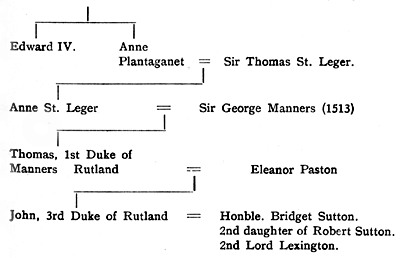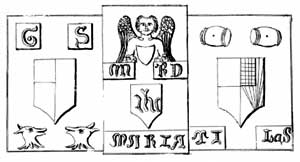The Suttons of Averham
By MR. GEORGE FELLOWS.
The display of heraldry on the tombs and tablets in this church is worthy of note, but before referring to the arms, some mention should be made of the Suttons of Averham, one of the most ancient, if not the most ancient family in Nottinghamshire still extant in the male line. It is usually said that they derived their name from Sutton-on-Trent, but there is some justification for tracing their origin to Sir Seward, Lord Sutton of Sutton, in Holderness, in the county of York.1
The person who composed the inscription on the tomb of the second Lord Lexington, at Kelham church, states that the family “has flourished in this county from time immemorial.” That is a somewhat wide assertion. We have, however, something more substantial whereby to establish their acknowledged antiquity, for in Thoroton’s History we find that in the time of Henry III. (1243), through failure male heirs in the Lexington family, the manor of Averham to Sir Roland Sutton, of Sutton-on-Trent, through his age with the heiress (Alicia) of the Lexington estates. A pedigree of the Suttons is also set out from the middle of 13th century, thus the family have an unbroken pedigree over six hundred years. The charming simplicity Sutton arms, viz., argent, a canton sable, denotes ancient grant.
To-day, however, our attention is focussed more especially on those members of the family whose tombs we see before us. The large table tomb of alabaster with its canopy against the north wall of the sanctuary is that of Sir William Sutton, who died in 1611. The tomb was erected by his widow, whose effigy lies beside his; she was Susanna, daughter of Thomas Cony, of Bassingthorpe, Lincoln; she bore him sixteen children. He is represented in plate armour of a period when armour was beginning to be less ponderous, and she has a goffered ruff, as usually worn by ladies in her day. There are three inscriptions on the tomb, two being in Latin and one in English, which runs:—
“Sir William Sutton’s corps here toombed sleepes,
Whose happy soul in better mansion keepes.
Thrice nine years liv’d he with his lady faire,
A lovely noble and like virtuous payer.
Their generous offspring (parents joy of heart)
Eight of each sex: Of each an equal part
Ushered to Heaven their father and the other
Remained behind him to attend the mother.”
There is a liberal display of heraldry. Surmounting the structure is a shield with Sutton quartering, Pierrepont, Lexington, Bingham, Musters, all local families with which the Suttons had allied themselves. At the top of the columns that support the entablature on either side are shields bearing the arms of Byron, argent, three bendlets, enhanced gules and Musters (argent, on a bend gules, a lion passant guardant or, a border engrailed of the second.1
Below the cornices of the columns and again on the base of the tomb are shields of Sutton and Lexington (argent, a cross flory azure) whilst in the spandrils of an arch at the back is a Sutton shield on one side and on the other a shield bearing arms presumably those of the lady, viz., Cony, here shown as fretty argent and azure, a chief gules, but these do not agree with the arms of Cony of Bassingthorpe, as given by Burke, viz., gules, on a bend double cotised or, three torteaux. Along the base is a line of seven shields bearing the Sutton arms, in four cases on the sinister side and in three cases on the dexter, while the other side of the shields are blank awaiting the nuptials of the survivors of the “eight of each sex” referred to in the inscription above, one having probably died meantime.
On the opposite wall is a large mural tablet, richly ornamented with shields of arms, to the first Lord Lexington, the son of the knight whose tomb we have just been inspecting. He was created Baron Lexington of Averham by King Charles I.; by letters patent bearing date at Oxford, November 21st, in twenty-first of Car.I. (1646) as some compensation for his services and probably for his fortune, as Dr. Thoroton informs us that he “ever kept a plentiful sober house and was much out of purse for King Charles 1st.” He died abroad on the 13th October, 1668, and his heart is said to be contained in a casket above the tablet. His widow dying in Paris the year following, her body was brought to Averham and there buried on 25th September, 1669.
This first Lord Lexington married three wives, but it was the third wife, Mary, daughter of Sir Anthony St. Leger, who furnished the heir to the title, namely, the illustrious Lord Lexington, whose tomb is at Kelham. It is, through this marriage, that the Suttons made a distant link with Royalty, thus:


Heraldry on Averham church porch.
At the top of all is a shield showing nine quarterings, viz., (i.) Sutton; (ii.) the Royal Lions of England (commemorating the alliance with royal blood?); (iii.) a lion rampant with a double queued tail; (iv.) Lexington; (v.) Picott; (vi.) Barry of Tollerton ; (vii.) Bingham ; (viii.) Musters ; (ix.) Sutton. Below there is a line of three shields, on which the Sutton arms are impaled with those of his lordship’s three wives, viz., (i.) with Manners; (ii.) Palmes; (iii.) St. Leger. On the porch is carved a Sutton shield with the initials T.S. denoting Sir Thomas Sutton, who died in 1526, opposite to which is a shield whereon Sutton is impaled with the arms of Bassett of Fledborough, viz., or, three piles meeting in the base of the escutcheon gules, a canton vairé argent and sable, Sir Thomas married Catherine Bassett of Fledborough. Above the latter are two barrels or tuns, a pun on the name of Sutton.
Fine views were enjoyed on the way to Upton, where the visit of the Society seems to have interested the inhabitants, as several attended in the church to hear Mr Gill's paper.
1) See Visitations of Notts., 1569 and 1614 (Harleian Society, edited by G.W. Marshall, p.186).
